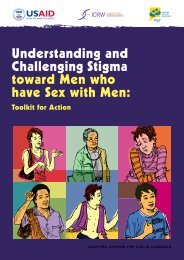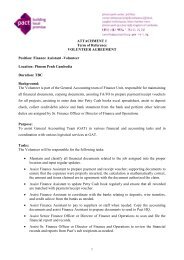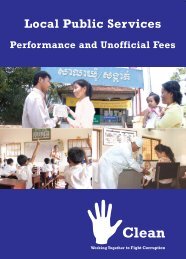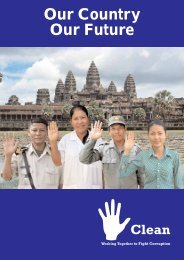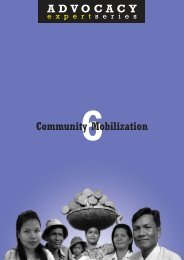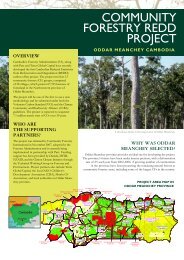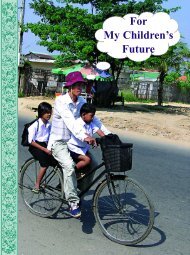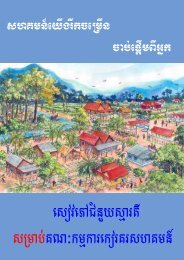Advocacy in Cambodia: Increasing Democratic ... - Pact Cambodia
Advocacy in Cambodia: Increasing Democratic ... - Pact Cambodia
Advocacy in Cambodia: Increasing Democratic ... - Pact Cambodia
Create successful ePaper yourself
Turn your PDF publications into a flip-book with our unique Google optimized e-Paper software.
<strong>in</strong>tervene are by activat<strong>in</strong>g the Labor Advisory<br />
Committee or press<strong>in</strong>g GMAC <strong>in</strong>to an <strong>in</strong>dustrywide<br />
agreement as it did <strong>in</strong> June 2000.<br />
Tripartite Labor Advisory Committee<br />
The 1997 Labor Law makes provisions for the<br />
establishment of a tripartite Labor Advisory<br />
Committee with the objective of br<strong>in</strong>g<strong>in</strong>g<br />
government agencies, companies, and unions<br />
together at the policy level. In all ten m<strong>in</strong>istries,<br />
five employer associations and five unions are<br />
represented on this committee, as are the<br />
<strong>in</strong>ternational labor agencies.<br />
The concept of a tripartite mechanism was<br />
<strong>in</strong>troduced by the ILO, which provided advice on<br />
its structure and role. Ma<strong>in</strong> activities <strong>in</strong>clude<br />
review<strong>in</strong>g proclamations <strong>in</strong> the light of worker and<br />
employer rights (although not all labor subdecrees<br />
and proclamations are passed through the<br />
committee). Much of the committee discussion to<br />
date has revolved around the m<strong>in</strong>imum wage but<br />
the unions’ most important agenda issue at the<br />
moment is protection of union leaders.<br />
As with mixed composition committees <strong>in</strong><br />
other sectors where government and civil society<br />
entities enter <strong>in</strong>to dialogue, committee discussions<br />
tend to be lively and power distribution uneven.<br />
The problem is that the Labor Advisory<br />
Committee is weak, meets <strong>in</strong>frequently, and is<br />
dom<strong>in</strong>ated by government and <strong>in</strong>dustry who can<br />
beat back, ignore, or out-vote any union <strong>in</strong>itiative<br />
that they do not like. Nevertheless, union leaders<br />
are ga<strong>in</strong><strong>in</strong>g experience <strong>in</strong> work<strong>in</strong>g at the policymak<strong>in</strong>g<br />
level. As it becomes more familiar to those<br />
<strong>in</strong>volved, it is conceivable that similar mechanisms<br />
could be used at the prov<strong>in</strong>cial or even enterprise<br />
levels.<br />
Role of International Entities<br />
By far the most important factor <strong>in</strong>fluenc<strong>in</strong>g<br />
labor conditions <strong>in</strong> <strong>Cambodia</strong> today is the<br />
<strong>in</strong>fluence wielded by <strong>in</strong>ternational<br />
entities. First among these is the <strong>in</strong>centive<br />
offered by U.S. import quotas. S<strong>in</strong>ce the<br />
U.S. imports the majority of <strong>Cambodia</strong>n<br />
export garments, the trade agreement<br />
provides an ongo<strong>in</strong>g mechanism to review<br />
progress made <strong>in</strong> work<strong>in</strong>g conditions and<br />
human rights.<br />
Dur<strong>in</strong>g the re-negotiation of the old<br />
trade agreement, which expired at the end<br />
of 2001, the trade association requested<br />
a 14% <strong>in</strong>crease <strong>in</strong> some garment<br />
categories. The U.S. government argued<br />
that access to factories, the arbitrary<br />
dismissal of union leaders, and the<br />
garment <strong>in</strong>dustry’s rights record were not<br />
satisfactory, although the companies<br />
themselves estimated that they had made<br />
significant ga<strong>in</strong>s with regards to improv<strong>in</strong>g factory<br />
work<strong>in</strong>g conditions. The new trade agreement,<br />
which was much lower than companies had hoped<br />
for, reflected the U.S. government’s concerns.<br />
The U.S. government and other <strong>in</strong>ternational<br />
entities have used their leverage to apply pressure<br />
for <strong>in</strong>creased participation of union leaders at the<br />
policy level. In one example, the <strong>Cambodia</strong>n<br />
government <strong>in</strong>vited representatives from the U.S.<br />
Embassy and other agencies to attend a meet<strong>in</strong>g<br />
on the content of a proclamation. When it was<br />
realized that only one <strong>Cambodia</strong>n union was<br />
present, the Embassy suggested that the meet<strong>in</strong>g<br />
be postponed until other unions could be <strong>in</strong>vited<br />
to attend. The strategy was successful <strong>in</strong> obta<strong>in</strong><strong>in</strong>g<br />
the participation of other unions <strong>in</strong> the discussion.<br />
The AFL-CIO and its <strong>in</strong>ternational arm,<br />
ACILS, have also been important actors <strong>in</strong><br />
strengthen<strong>in</strong>g the local labor movement. AFL-CIO<br />
assisted with the draft<strong>in</strong>g of the Labor Law, and<br />
<strong>in</strong> August 1997 called on the U.S. to revoke<br />
<strong>Cambodia</strong>’s special trad<strong>in</strong>g status and accused the<br />
government of facilitat<strong>in</strong>g registration of progovernment<br />
unions. S<strong>in</strong>ce the end of 2000, ACILS<br />
has been provid<strong>in</strong>g trade union staff and factory<br />
leaders with tra<strong>in</strong><strong>in</strong>g <strong>in</strong> barga<strong>in</strong><strong>in</strong>g and other<br />
union skills, and also tracks labor disputes.<br />
The ILO garment project, <strong>in</strong>itiated <strong>in</strong> 1998,<br />
provides tra<strong>in</strong><strong>in</strong>g, monitor<strong>in</strong>g, and assistance with<br />
dispute resolution. Leaders from six unions sit on<br />
a Project Advisory Committee and meet on a<br />
regular basis. The newly established ILO<br />
monitor<strong>in</strong>g project, which is tied <strong>in</strong>to the quota<br />
system, assists companies to make progress <strong>in</strong><br />
work<strong>in</strong>g condition improvement, helps establish<br />
improved conditions for workers, and provides<br />
garment lot buyers/contractors confidence <strong>in</strong><br />
<strong>in</strong>vest<strong>in</strong>g <strong>in</strong> <strong>Cambodia</strong>. The ILO will soon start a<br />
project to research factory wages and conduct a<br />
survey of market goods prices <strong>in</strong> order to def<strong>in</strong>e<br />
Case Studies<br />
63




